Follow us 261.1k
When you follow a healthy low-carb diet, you'll need to swap commonly used high-carb foods for low-carb ingredients. Contrary to common misconceptions, there are loads of low carb alternatives to almost any foods and this guide will help you make the right choices when you follow a ketogenic diet. With our ultimate keto food cheat sheet you will never miss bread, pasta, rice or sugar.
We created a Keto Food Swaps infographic for you.
Click here to view, pin & print it.
Why Keto Food Swaps?
These days I rarely use sweeteners or bake bread but it wasn't always like that. I know how hard it is when you give up foods you love. My aim is to help you make the transition to keto as effortless as possible.
Does this mean that you can be eating keto bread or treats every day? Absolutely not. Instead, learning to eat real, nutritious food naturally low in carbs is the best strategy to succeed in the long term.
Having said that, there is nothing wrong with having an occasional treat or a "proper" keto burger. And it's always better to opt for a healthy low-carb alternative rather than having weekly cheat days and end up eating loads of carbs, gluten and processed foods.
In this guide I focus on the most commonly used high-carb ingredients and their best low-carb alternatives. In an upcoming post I'll explore the best keto alternatives to common meals and restaurant favourites, low-carb baking and kitchen hacks.
Best Low Carb Alternatives to Sugar and Syrups
The top 5 keto-friendly sweeteners are stevia, Erythritol, monk fruit, Xylitol and yacon syrup. The amount of low-carb sweetener you will need depends on the type and your palate. As you get used to low-carb eating, you will likely use smaller amounts, or you may even avoid sweeteners altogether.
Stevia, Erythritol, Allulose and Monk Fruit

Stevia, Erythritol, Allulose and monk fruit are ideal because they have no effect on blood sugar and zero calories. Most people tolerate them well and they can be used to taste.
Beware that some sweetener blends may contain blood sugar spiking ingredients such as dextrose and maltodextrin and you should avoid them completely. Always read the labels and beware that all IMO syrups can raise blood sugar!
Some of the best products are NuNaturals, Swerve, Sukrin, So Nourished, and Lakanto. Allulose is a fairly new sweetener that may not be available in all countries. In the US you can find plenty Allulose based sweeteners on Amazon.
Xylitol and Yacon Syrup

Xylitol and yacon syrup are suitable options too. Just make sure to use them sparingly and stick to the recommended amount per serving as they may affect your blood sugar or cause digestive distress.
Our list of top 5 Sweeteners and Sweetener Conversion Chart will help you get started.
Best Low Carb Alternatives to Pasta
Vegetable Noodles: Zucchini, Palmini, Cabbage and Fennel
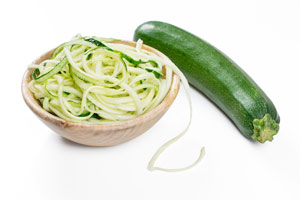
One of the most common substitutes for pasta is zucchini noodles, also known as "zoodles", which is essentially spiralized or julienned zucchini (courgette in the UK). In fact, zucchini is not the only keto-friendly vegetable you can spiralize. Try rutabaga (swede), turnips, celeriac or even cucumber.
To get the best out of zoodles, follow a few simple rules: Sprinkle the zoodles with salt and leave in a colander to drain. Pat dry with a paper towel and cook on a greased pan briefly for 1 to 3 minutes, depending on the preferred doneness.
Other pasta alternatives include:
Shirataki Noodles
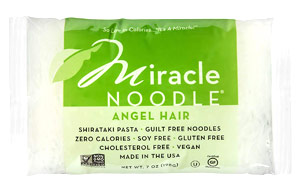
Shirataki noodles, also known as miracle noodles and konjac noodles are popular in Asian cuisine. They are made from the konjac plant which is ground and then shaped into noodles, fettuccini or even rice. Shirataki noodles contain virtually zero calories and zero carbs.
If you are new to this zero-carb ingredient, make sure to read my guide to on How To Prepare Shirataki Noodles. Without proper rinsing and preparation, they have an unpleasant odour and texture. There are several brands selling shirataki noodles on Amazon. Make sure to read the labels as some products may contain ingredients such as bean flour.
Kelp Noodles

Kelp noodles are a low carb alternative to regular noodles and boast some great health benefits such as being high in iodine, calcium, and iron. Unlike shirataki noodles which are soft and chewy, kelp noodles have a crunchy texture and can be eaten raw. You simply need to rinse them in cool water before serving. Thanks to their crunchy texture, kelp noodles are ideal for salads.
If you prefer them soft, you can soak them in hot water or add to a hot soup after rinsing. Just like shirataki noodles, there are several brands selling kelp noodles on Amazon.
Other Pasta Alternatives
I have yet to discover the perfect pasta recipe (if there is such a thing) but there are some that are very close to the real deal:
Best Low Carb Alternatives to Rice
Cauliflower Rice

Cauliflower rice is such a versatile keto ingredient. Apart from using cauli-rice as a side, I like to add mine to scrambled eggs, breakfast skillets, low-carb casseroles and even poke bowls. It can even be used instead of couscous.
Cauli-rice can even be used in keto sushi rolls. Just add some homemade mayo or cream cheese to create the sticky effect and you are good to go!
You can make cauli-rice in advance and keep it in the fridge for up to 4 days. Although freshly prepared cauliflower rice can be frozen, I prefer not to freeze mine as it may result in an unpleasant odour and texture. There are several ways you can prepare and cook cauli-rice. Whatever method you use, do not over-process the cauliflower. The best way is to use a food processor with a grating blade. This way you will achieve the best texture and pieces resembling real rice.
Apart from cauliflower, other non-starchy vegetables that can be used to make "rice" include broccoli and celeriac.
Shirataki Rice
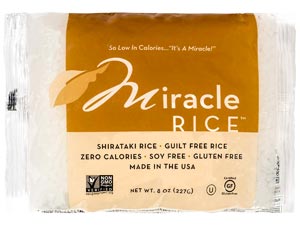
Just like cauliflower rice, shirataki can be used as a side dish, or added to all sorts of keto recipes. It has fewer carbs than cauliflower rice and is ideal for those who keep their carb limit very low. You can even combine some cauliflower rice and shirataki rice to suit your taste.
Beware that just like shirataki noodles, shirataki rice may reduce the bioavailability of oral medications. Any oral medications should be taken 1 hour before or 4 hours after any meal containing shirataki (glucomannan). Because it may also reduce the bioavailability of vitamins and minerals, you should not overuse products containing glucomannan. The vast majority of your diet should be focused on real food high in nutrients!
Best Low Carb Alternatives to Potatoes
Rutabaga, Turnips, Radishes, and Cauliflower
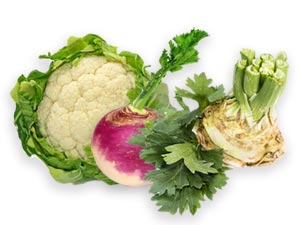
All of these low-carb options are ideal substitutes for potatoes. Just like potatoes, you can roast, fry, mash or boil them. Other similar vegetables that can be swapped for potatoes are kohlrabi and celeriac.
I use a high-speed blender for a very smooth texture, like I did in this Keto Celeriac Cauli-Mash, or you can use an immersion blender if you prefer your mash chunky.
Of all of the options I've tried, rutabaga works best as an alternative to potato fries. Another great option popular in the keto community seems to be jicama although I haven't tried it myself and it may not be available outside the US.
Other vegetables such as zucchini, eggplant or mushrooms are a good alternative to crispy snacks like potato crisps.
Winter Squash
Another great alternative to potatoes is pumpkin, as well as other types of winter squash such as Kabocha squash, Butternut and Coquina squash, Acorn squash and more. You can find more about the carb count in different types of squash in this recipe Homemade Pumpkin Purée.
The reason I'm listing winter squash separately is its relatively higher carb count. While it's ideal for a low-carb diet, you will need to keep the serving size small, especially if your carb limit is very low. Our KetoDiet app can help with that and so much more!
Best Low Carb Alternatives to Cereals
Nuts, Seeds and Coconut
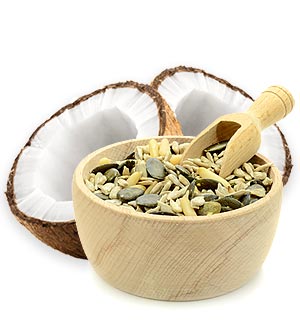
Cereal, cornflakes, granola and porridge can easily be replaced with different sorts of nuts and seeds. Flaked coconut (coconut chips), flaked or slivered almonds, chia seeds and hemp seeds are some of the best options.
My favourite recipe only takes 5 minutes to prepare. I simply drizzle some unsweetened coconut chips and flaked almonds with virgin coconut oil, sprinkle with cinnamon and pan-roast for 2-3 minutes, just until lightly browned and fragrant. I use it as a topping on full-fat Greek yogurt or with unsweetened almond milk and berries. It can't get easier than that.
Whenever I make my keto porridge, I always add some hemp seeds. They are one of the best sources of magnesium, an electrolyte often deficient in modern diets. And if you just started following a ketogenic diet, you need to up your electrolytes to avoid keto-flu.
From keto granola and cinnamon toast crunch to low-carb porridge and chia pudding - the options are endless!
Best Low Carb Alternatives to Wheat Flour
Nut, Seed & Coconut Flour

When you follow a keto diet, you have to give up grains. The best alternatives are finely ground nuts, seeds and coconut. The most commonly used are almond flour, coconut flour, flax meal and psyllium powder. Ground sesame seeds will work in a similar way as flax meal while defated sesame flour is closer to defated almond flour or coconut flour.
Over the years I created many different types of keto breads and keto dessert recipes including pies, tarts and cakes. And there are loads of great keto blogs with healthy dessert alternatives but if I were to pick just one, my friend Carolyn of All Day I Dream About Food has some of the best recipes for low-carb cakes, pies and any treats you can imagine!
There is no universal guide for substituting wheat flour or any grain flour but there are a few simple rules you should follow. Low-carb baking is a large topic on its own and I will get into more detail in my upcoming post in which I'll discuss all available options and how to swap them.
Best Low Carb Alternatives to Breading
Flax Meal, Almond Flour, Pork Rinds and Parmesan

Instead of regular high-carb breading you can use flax meal, almond flour, ground pork rinds or grated Parmesan cheese. You could even use coconut flour although I wouldn't recommend it on its own but rather combined with one of the other suggested ingredients. These Keto Breadcrumbs are the closest I ever got to the real deal.
Pork rinds are not always free of additives and I prefer making my own. If you don't eat pork, try Chicken Cracklings instead.
Best Low Carb Alternatives to Legumes

Apart from peanuts which are keto-friendly (although not everyone can eat them), other types of legumes are excluded from the keto diet food list because they are high in carbs.
Some of the most common substitutes for legumes are macadamias, eggplants (aubergines in the UK) and green beans.
Macadamia Nuts
Macadamia nuts are a fantastic alternative to chickpeas and ideal for making keto hummus. Macadamias are a good source of heart-healthy fats and they are very low in carbs.
Eggplant and Green Beans
Low-carb vegetables, especially eggplants and green beans, are a good alternative to beans and lentils in soups and stews.
Best Low Carb Alternatives to Bread & Wraps
Bread & Tortillas

Making keto bread is not as hard as it may sound and it can taste just as good as regular high-carb bread. Of all the different types of keto breads I've created since going low-carb, the number one recipe has always been the Ultimate Keto Buns.
There is a keto bread recipe for everyone no matter what your food intolerances are: dairy-free, nut-free, psyllium-free and flax-free.
Tortillas seem to be hard to substitute but these Keto Tortillas are amazing and taste just like the real deal.
Lettuce, Chard, and Collards
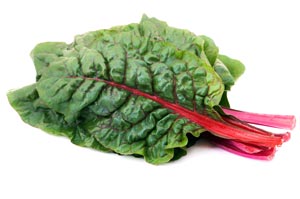
If you want to avoid bread and tortillas altogether, simply swap them with fresh lettuce, chard or collard leaves. Crispy iceberg lettuce is a great substitute for tacos and bunless burgers. Soft lettuce, chard and collards can be used to make keto wraps, unwiches and hand rolls.
Nori Sheets
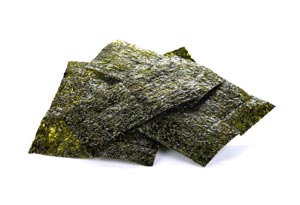
Similar to lettuce leaves, nori sheets are ideal for making keto wraps, sushi rolls and hand rolls. Nori sheets are low in carbs and high in iodine. One nori sheet contains virtually zero carbs!
Simply use them just like chard leaves and fill them with healthy fats, non-starchy vegetables and protein.
Best Low Carb Alternatives to Milk
Dairy milk is high carbs and should be avoided when you follow a keto diet. These are the best alternatives to milk.
Nut and Seed Milk
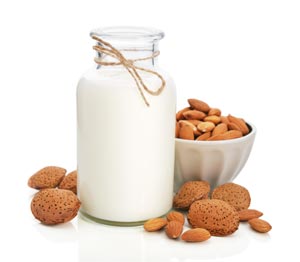
You can use any unsweetened nut milk or seed milk. You can buy unsweetened almond milk or cashew milk in most health stores and on Amazon. Beware of hidden carbs and other unwanted ingredients like added sugar, starches and thickeners. Avoid products containing soy milk or rice milk.
If you can't find a good product without sugar and thickeners, make your own nut and seed milk - it's easy!
Coconut Milk
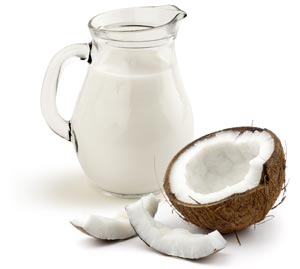
Just like nut and seed milk, coconut milk can be used instead of regular dairy milk. There are several options available, although very few contain no thickeners like guar gum which gives most products a distinctive aftertaste. If you don't like the aftertaste of thickeners or they are causing digestive issues, you can make your own coconut milk.
If you don't like plant-based milk options, simply use heavy whipping cream diluted with water. Note that some people may be able to tolerate small amounts of full-fat milk (e.g. used in coffee).
Best Low Carb Alternatives to High-Carb Fruits
Apart from a few exceptions, most fruits are high in carbs. There are, however, a few exceptions you can have when you follow a ketogenic diet.
Berries

Most berries are low in sugar and carbs and can be used in moderation. The best option for keto are blackberries, raspberries, strawberries and blueberries. Here's the carb count per 1/2 cup of whole berries:
- blackberries: 3.1 g net carbs
- raspberries: 3.3 g net carbs
- strawberries: 4.1 g net carbs
- blueberries: 7.3 to 9.1 g net carbs (wild blueberries contain fewer carbs)
Avocado, Coconut and Other Low-Carb Fruits

Avocado is not just the most keto-friendly fruit but it's also one of the most nutrient-dense foods you can eat on keto. It's a great source of potassium and heart-healthy monounsaturated fats. Coconut is very low in net carbs, high in fiber and saturated fats.
Other options suitable for a low-carb diet are rhubarb and watermelon. Keep in mind that not all low-carb fruits are suitable for everyone. Apart from portion control, you need to consider how they affect your blood sugar levels.
Healthy Alternatives to Vegetable Oils
Inflammatory vegetable oils, margarine, hydrogenated oils, partially hydrogenated oils, other trans fats and interesterified fats are all damaging to your health. In fact, eating these fats can be just as bad — if not worse — than following a high-carb diet.
Below are the healthiest fats and oils to use (not just) on a ketogenic diet. The simple rule is to use saturated fats for cooking and monounsaturated fats mostly for cold use. Below are the best options.
Butter & Ghee
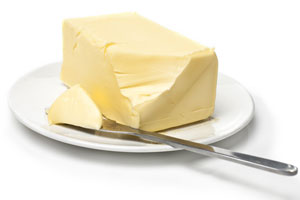
I use ghee to cook most of my meals. It tastes just as delicious as butter but doesn't burn. You can still use butter but add it to your meals at the end of the cooking process, or use it to make Keto Hollandaise or fat bombs.
Want to give your ghee an anti-inflammatory boost? Make a batch of my Golden Ghee!
Olive Oil and Avocado Oil

Just like avocados and macadamia nuts, extra virgin olive oil is a fantastic source of heart-healthy monounsaturated fatty acids (MUFA).
Oils high in MUFA such as olive oil, avocado oil, hazelnut oil and macadamia nut oil are best for cold use, for finishing meals or after cooking. Always opt for extra virgin olive oil.
Coconut Oil and MCT Oil
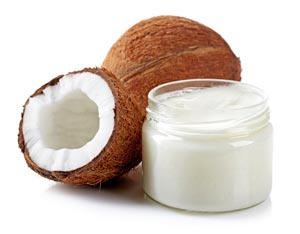
Coconut oil is high in saturated fats and medium chain triglycerides (MCTs) and is suitable for both cooking and cold use. Saturated fats are the most stable when heated, have long shelf lives and high smoke points. Use these oils for most of your cooking. Always opt for virgin coconut oil.
Unlike coconut oil, pure MCT oil is always liquid and doesn't solidify even in the freezer. That's why it's the ideal for keto smoothies and keto ice cream.
Lard, Tallow & Duck Fat

Other healthy options high in saturated fats are pork lard, beef tallow, mutton tallow, duck fat, schmaltz (chicken fat) and goose fat. All these fats are heat-stable and ideal for cooking. Quality matters so always opt for lard from outdoor-reared pigs.
To learn more about the best and the worst fats on keto, check out our Complete Guide To Fats And Oils.
Infographic
Here's our Keto Food Swaps infographic we created for you - click on it to see the large version. Feel free to pin, share and print it!
 Follow us 148.4k
Follow us 148.4k
Do you like this post? Share it with your friends!
Let us know what you think, rate this post!
